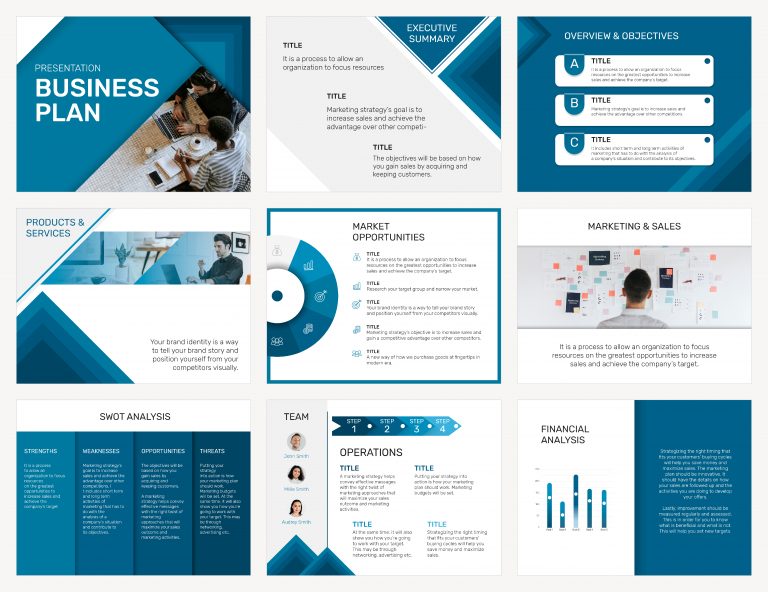Knowledge Base > Presentations > Marketing Plan – the Complete Guide
Marketing Plan – the Complete Guide
Marketing is the secret ingredient that can take your business to new heights, providing your team with a sense of direction, deadlines, actionable tactics, and the tools needed to achieve those all-important business goals. But creating a marketing plan can feel like a daunting task if you’re new to the planning game so make sure you create a winning marketing plan with our presentation creator , so it can be as eye-pleasing as the one below:
Publuu’s marketing plan example
View more marketing plan examples
You might ask yourself how to write a marketing plan and whether you need marketing plan templates. Luckily for you, we’re here to help!
Did you know that most businesses spend the most on marketing – right after salaries? As a business owner or marketer, it’s crucial to make the most out of every dollar in your marketing budget. But too often, businesses dabble in various marketing tactics without a solid plan and, as a result, struggle to make it big.
The reality is, every business needs a rock-solid marketing plan to truly flourish. But in their quest for success, many brands try different marketing strategies without a cohesive plan, leading to a bumpy road!
But if you successfully create a marketing plan, that’s only half of the road. Marketing plan presentation is also important – and you can use interactive flipbook maker to publish your documents online and ensure they will be easily accessible by all.
To create a winning marketing plan, you’ll need to integrate social media, content, and paid ads seamlessly, and we know it can feel a bit overwhelming. This is why we decided to create this article. This article will explain how to write your own marketing plan that works wonders for almost any business. With our marketing plan examples, you’ll be off to a fantastic start in no time!
What is a marketing plan?

A marketing plan is a blueprint for an organization’s overarching advertising strategy to generate leads and connect with its target audience. The marketing plan offers a comprehensive overview of the outreach and PR campaigns that the company will undertake and outlines how its success will be measured. In essence, a marketing plan is a vital tool that helps organizations plan, execute, and track their marketing activities to achieve their goals.
A marketing plan can contain market research, demographic analysis, recommended advertising platforms, analytics methods, and effective marketing practices.
A well-structured marketing plan provides several essential benefits. Firstly, it outlines the strategy a company will employ to promote its products or services, helping to identify what works and what doesn’t. With a plan in place, you can quickly pinpoint target markets, brand or product value propositions, campaigns, and metrics to evaluate marketing success.
Furthermore, you should also be able to make regular adjustments to the details based on the performance of various initiatives you come up with when you create a marketing plan. The plan also simplifies campaign management by consolidating all pertinent information in one place.
Your marketing team should be able to grasp the overall strategy and specific tactics through a clear and concise marketing plan. An ideal marketing plan includes marketing objectives, buyer personas, high-level marketing strategies and tactics, strategy timelines, budget considerations, and a method for assessing the effectiveness of the strategy.
What’s the difference between a marketing plan and a marketing strategy?

In simple terms, a marketing strategy refers to the overall approach or high-level roadmap that a company will follow to achieve its marketing goals. It is the general idea that outlines the direction and framework for your marketing team. A marketing strategy instead focuses on understanding your target market, analyzing your competitors, and determining the unique value proposition that sets your business apart.
On the other hand, a marketing plan is similar to white paper – detailed and practical document that describes an issue and how can it be solved. It outlines the specific marketing actions, tactics, and campaigns that will be used to reach the target market and achieve the marketing objectives. A marketing plan typically includes information on budgets, timelines, resources, and metrics that will be used to track progress and measure success.
To sum it up, a marketing strategy is the “what” and “why” of your marketing activities, while a marketing plan is the “how” and “when.” The strategy provides the direction and overall vision, while the plan translates this into actionable steps and tactics.
Both components are essential for a successful marketing campaign, as they complement each other and ensure that your marketing efforts are well-coordinated and effective.
How to make a marketing plan in 7 easy-to-follow steps
Mission, vision, and value

Begin your marketing plan by establishing your company’s mission, vision, and values. The mission outlines the purpose of your business, while the vision represents your long-term goals and objectives.
The values described in your marketing plan reflect the principles and standards that guide your company’s operations and your general marketing strategy. By defining these elements, you provide a solid foundation for your marketing plan and ensure that your marketing actions are aligned with your business’s overall objectives.
Create a short executive summary
The executive summary is a brief overview of your entire marketing plan. It should concisely highlight the key elements, such as objectives, strategies, tactics, and expected outcomes. The purpose of the executive summary is to provide a quick snapshot of your plan, allowing stakeholders to grasp the essentials without delving into the details. After all, business readers are busy people – and they have no time to learn your entire marketing strategy.
If you want to summarize your own marketing plan easily, feel free to use pitch deck creator to provide your readers with a quick and concise summary of your marketing strategy and plan.
Set key performance indicators

Key performance indicators (KPIs) are measurable values that demonstrate the effectiveness of your marketing team in achieving your objectives. Identify relevant KPIs for your marketing plan, such as leads generated, conversion rates, website traffic, or social media engagement. By monitoring these metrics, you can track your progress and make data-driven decisions to optimize your marketing campaigns. These factors can affect your marketing goals and you will use them to determine whether the general marketing campaign is successful.
Identify your targets
Define your target market by creating detailed buyer personas. These personas should represent the ideal customers for your products or services, including information on demographics, preferences, pain points, and motivations. By identifying your targets, you can tailor your marketing messages and campaigns to resonate with the people most likely to purchase from you.
Define strategy and execution

Outline the marketing strategies and tactics you’ll use to reach your target audience and achieve your objectives. This may include content marketing, social media, email marketing, paid advertising, or other approaches. Be sure to include specific marketing goals, action items, timelines, and resources required for each tactic, ensuring a clear roadmap for your marketing team to follow.
Outline your plan’s contributors and responsibilities
Identify the team members responsible for executing various aspects of your marketing plan. Clearly define their roles and responsibilities to ensure accountability and smooth collaboration. By assigning tasks and setting deadlines, you can keep your marketing efforts on track and minimize the risk of missed opportunities.
Present your marketing plan with Publuu
Finally, showcase your marketing plan using a platform like Publuu. This tool allows you to create an interactive, visually appealing presentation that can be easily shared with stakeholders. By presenting your marketing plan using a flipbook maker in an engaging format, you can communicate your strategy effectively and generate enthusiasm and support from your team and other decision-makers.
These flipbooks provide a modern, engaging, and user-friendly way to showcase your marketing plan, making it more appealing and accessible to your audience. They’re easy to read on smartphones, tablets, and desktop computers, without the need to install any software or files.
The page-turning effect, interactive elements, and multimedia content contribute to a more engaging and enjoyable browsing experience, which will captivate your audience and distinguish your marketing plan from the competition. 
Publuu HTML-5-enabled flipbooks support the integration of various multimedia elements, such as videos, images, and hyperlinks. These features help to present the marketing plan in a more dynamic and interactive way, keeping your audience interested and informed.

What are the 4 types of marketing plans?
There are several types of marketing plans, each focusing on specific aspects of marketing strategy and execution. While various categorizations exist, here are four common types of marketing plans:
-
Content Marketing Plan : A content marketing plan focuses on the creation, distribution, and promotion of valuable, relevant, and consistent content to attract and engage a clearly defined target group. The primary objective of a content marketing plan is to drive profitable customer actions by offering content that educates, entertains, or informs.
This plan outlines the types of content to be produced (such as blog posts, videos, podcasts, infographics, or ebooks), the target audience, publishing frequency, distribution channels, and promotional strategies.
-
Social Media Marketing Plan: A social media marketing plan focuses on leveraging social media platforms to promote a company’s products, services, or brand, and to engage with its intended audience.
This plan outlines the social media channels to be used (such as Facebook, Instagram, Twitter, LinkedIn, or Pinerest), the types of content to be shared, and the posting schedule. The social media marketing plan also includes information on the brand’s tone and voice, social listening, and community management strategies, as well as guidelines for responding to comments, messages, and reviews.
-
Product/Brand Marketing Plan : A product or brand marketing plan focuses on the marketing efforts for a specific product, product line, or brand within a company. This plan outlines the product or brand positioning, main audience, unique selling proposition (USP), and the marketing strategies and tactics needed to promote it effectively. It also includes information on product pricing, distribution, and promotional activities.
-
Digital Marketing Plan: A digital marketing plan focuses on the online marketing efforts of a company, including website optimization, social media marketing, search engine optimization (SEO), pay-per-click (PPC) advertising, email marketing, and content marketing. A well-structured digital marketing plan is crucial for reaching and engaging customers online, driving website traffic, and generating leads and conversions.
What are the 7 elements of a marketing plan?
A comprehensive marketing plan consists of several key elements that work together to create a coherent and effective strategy. Here are the seven main elements of a marketing plan:
Executive Summary

The executive summary provides a brief, high-level overview of the entire marketing plan, touching on its main components and goals. This section is typically written last but placed at the beginning of the plan, allowing stakeholders to quickly grasp the essentials.
Company Overview and Situation Analysis
This section outlines the company’s background, mission, vision, values, and current market position. It also includes a situation analysis, which covers the internal and external factors affecting the business, such as strengths, weaknesses, opportunities, and threats (SWOT analysis), and an evaluation of the competitive landscape.
Marketing Objectives
Clearly define the marketing goals and objectives you want to achieve within a specific time frame and within your marketing budget. These objectives should be specific, measurable, achievable, relevant, and time-bound (SMART). Examples of marketing goal include increasing brand awareness, generating leads, boosting website traffic, or growing sales.
Target Market and Buyer Personas

Identify your target market and create detailed buyer personas representing your ideal customers. This information should include demographics, preferences, pain points, and motivations. Understanding your target audience enables you to tailor your marketing messages and campaigns to better resonate with them, increasing the likelihood of conversion.
Marketing Strategies and Tactics
Outline the marketing strategies and tactics you will employ to achieve your objectives and reach your target audience. This may involve content strategy, social media, email marketing, paid advertising, or other approaches. Be specific about the actions, resources, and timelines required for each tactic, providing a clear roadmap for your marketing team.
Marketing Budget and Resources
Determine the budget required to execute your marketing plan, taking into consideration staff, tools, advertising spending, and other expenses. Allocate resources accordingly and identify potential areas for cost optimization. Having a clear budget ensures that your marketing efforts remain financially sustainable and aligned with your company’s overall financial goals.
Monitoring, Measurement, and Analysis
Define the key performance indicators (KPIs) you will use to measure the success of your marketing campaigns and track progress towards your objectives. Establish a process for regularly monitoring, measuring, and analyzing these KPIs, allowing for data-driven adjustments and optimization of your marketing efforts. This element is crucial for understanding the effectiveness of your marketing plan and making informed decisions moving forward.
Marketing plan examples
You can use this Publuu example to see how to publish an executive summary or an annual marketing plan. Thanks to the prestigious background, and realistic page-turning effect and the ease of publishing it on social media, you can draw attention to marketing plans you design to impress.

The marketing plans for the University of Ilinois shows proper market research and notes the various group of target customers the school can reach. Use it as an inspiration for your own marketing plans.

You can use this business plan template as a marketing plan template to make both of them work in the same plane and fetch better results. With this example used in your presentation, you can effortlessly showcase your marketing strategy to the wider audience with these designs and variety of different slides.
Free marketing plan templates
Executive summary template
This executive summary template allows you to include key information in a form of a brief overview of the marketing plan. It should be one of the first pages so busy businesspeople and your coworkers can easily glance at the summary and have an idea of the overall plan.
SWOT analysis template
This template representing SWOT analysis is a great way to showcase strong points, weaknesses, opportunities and threats which the following execution of the marketing plan can carry with itself. Make sure to include one to have a better understanding of the opportunities, as well as possible consequences.
Customer profile template

Customer profile allows you to focus your interest on your perfect customers that will further interact with your products or service. This template in particular allows you to extend your researched area of your customer by benefits and pain points of the customer.
Marketing budget template

Making your plan as efficient as possible would not be possible without a proper distribution of funds. Make sure you do not miscalculate a single dollar with this template above.
Marketing report template

The following template is a nice, corporate-like report to wrap up all of your contents into one place. No one has said that your report has to be boring, so make sure you do not miss out on both eye-pleasing template and straightforwardness of the contents included.
Conclusion
In conclusion, a well-crafted marketing plan is crucial for the success of any business looking to expand its customer base and boost revenue.
It’s a well thought marketing strategy that provides a clear roadmap for the marketing team, outlining the various objectives, strategies, and tactics required to achieve the desired results.
By integrating various marketing tactics such as social media, content, and paid ads, a comprehensive marketing plan can help companies create a coherent and effective marketing strategy. It is essential to include key components such as buyer personas, high-level marketing strategies and tactics, strategy timelines, budget considerations, and a method for assessing the effectiveness of the marketing plan.
Publishing the marketing plan using Publuu flipbooks grants it ease of use and availability online. A successful marketing plan requires a lot of preparation and a focus on your audience – and Publuu flipbook maker can help you achieve this.
With the right marketing plan in place, businesses can achieve their goals and establish themselves as market leaders in their respective industries.
You may be also interested in:
What is a Pitch Deck?
10 Tips on How to Start a Presentation and Impress Your Audience
Convert your PDF to flipbook today!
Go beyond boring PDF and create digital flipbook for free.
Register with Publuu for free today and check out all the smart options we prepared for you!

















